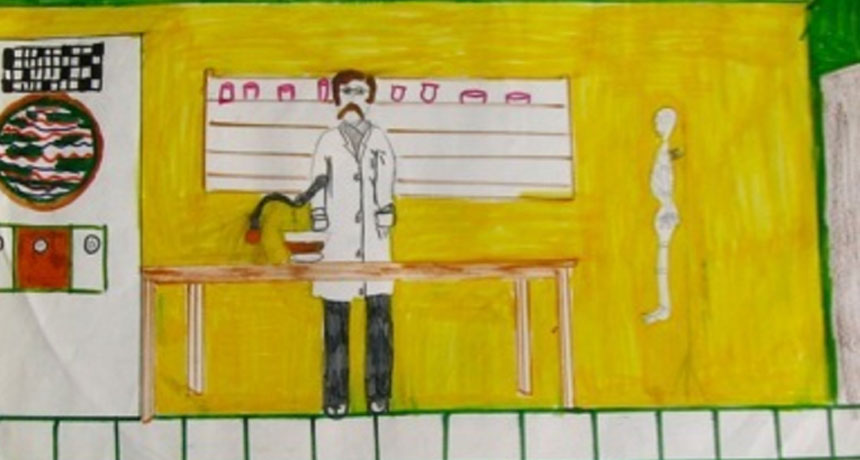Students depict more scientists as women than ever
Fewer kids see most scientists as men — at least based on what they’re drawing

When asked to draw a scientist, 40 years ago, more than 99 percent of kids drew men. What about now?
Yewhoenter, CC BY-SA
WASHINGTON, D.C. — When asked to draw a scientist, most students will draw an old man, with Einstein-like frizzy hair, glasses and a lab coat. Or at least, they did in the 1970s. What about now? The balance is tipping, new data show. More kids — especially girls — are now drawing female scientists.
The original test to “draw a scientist” was designed to figure out just how kids see researchers. In the original study of nearly 5,000 children, the results were clear. Children depicted scientists as old white men in lab coats. Only 28 drew female scientists, and all who did were girls.
But that original study took place in the late 1970s. It’s been more than 35 years since then. Scientists and teachers have been making efforts to get more women into science and to show that science isn’t just a boy’s club. Have their efforts had much effect on how kids view scientists? David Miller decided to find out. He’s a psychologist — someone who studies how the human mind works — at Northwestern University in Evanston, Ill.
To find out if attitudes had changed over time, Miller gathered together 30 “draw a scientist” studies performed between 1985 and 2010. Together, they involved more than 7,300 children from 5 to 18 years old. Then he analyzed all of those data together. This is called a meta-analysis — a technique that scientists use to scout for patterns across data from different scientific papers.
Meta-analyses can be useful because they allow scientists to compare many different studies against each other. But these tests also can sometimes “find” small effects that aren’t reliable. They also rely on published studies — and many, many studies never end up published. But when done well, meta-analyses can help scientists find an effect across many studies — or as in this case, across time.
When it comes to drawing female scientists, things are looking up, Miller and his colleagues find. In the original “draw a scientist” study, more than 99 percent of the students drew a man. By the mid-1980s, more than 80 percent were still drawing guys. But the share of kids drawing women has been climbing. By 2010, only about 60 percent of the students still drew male scientists.
That 40 percent now draw female scientists is encouraging news, Miller says. Indeed, in the 15 studies where the gender of the students was identified, fully half of the girls were drawing women scientists by 2010. Less encouraging: Between 85 and 90 percent of the boys are still drawing male scientists. Then again, Miller says, that’s not surprising. “If asked to ‘draw a person,’ children are more likely to draw their own sex,” he says. Miller presented his findings here, February 14, at the annual meeting of the American Association for the Advancement of Science.
The change in the share of women over time may reflect changing stereotypes, says Amelia Grant-Alfieri. She’s a science teacher at Barrie School in Silver Spring, Md., who was not involved in the study. She’s not sure that what a student draws is really what they think. “I wonder if just asking for one drawing is really reflective of what a young man thinks” — at least in terms of whether women can be scientists, she says.
It’s important to continue to combat the stereotype, Miller notes. Teachers and parents can help by including female scientists when they talk about science. But focusing on just one female scientist, such as Ada Lovelace or Marie Curie, isn’t going to be enough. “Single examples don’t change stereotypes,” he argues. “Don’t have one token lady scientist.” Instead, he says, “Make it normal to discuss female scientists.”
As scientists, teachers and parents all work to show that scientists aren’t all male, students may one day be as likely to draw a woman as a man. But there’s one more hurdle that has yet to be overcome. No matter what the year, students drew scientists with glasses and lab coats, Miller says. To him, that doesn’t mean they are professionals. Instead, he says, “children still see scientists as just as nerdy as they did in the 1980s.” Some stereotypes die hard.
Follow Eureka! Lab on Twitter
Power Words
(for more about Power Words, click here)
meta-analysis A technique in which scientists pool a large number of previous scientific studies on a single topic, and try to identify patterns among them. Meta-analyses allow scientists to look at many studies at once and so work with a large amount of data. But they also can be biased. They rely only on data that has already been published (and so might ignore studies that weren’t published because the researchers didn’t find anything). In addition, most scientists don’t do studies in exactly the same way. The tiny differences between studies could affect the results of the meta-analysis. Finally, with so many papers pooled together, a meta-analysis might pull out effects that aren’t really there at all. But if done correctly, these tests can be a good tool to find out if an effect is present across many different studies.
psychology (adj. psychological) The study of the human mind, especially in relation to actions and behavior. To do this, some perform research using animals. Scientists and mental-health professionals who work in this field are known as psychologists.
stereotype A widely held view or explanation for something, which often may be wrong because it has been overly simplified.